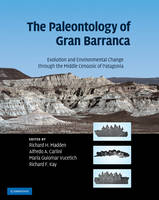
The Paleontology of Gran Barranca
Cambridge University Press (Verlag)
978-0-521-87241-6 (ISBN)
Gran Barranca in Patagonia exposes the most complete sequence of middle Cenozoic paleofaunas in South America. It is the only continuous continental fossil record of the Southern Hemisphere between 42 and 18 million years ago, when climates at high latitudes transitioned from warm humid to cold dry conditions. This volume presents the geochronology of the fossil mammal sequence and a compilation of the latest studies of the stratigraphy, sedimentology, mammals, plants, invertebrates and trace fossils. It is also the first detailed treatment of the vertebrate faunal sequence at Gran Barranca, providing important new evidence about biotic diversity and evolution in the native species. A revised taxonomy allows a reevaluation of the origination and extinction of herbivorous mammals, marsupials, and xenarthrans, and the earliest occurrence of rodents and primates in southern latitudes. Academic researchers and advanced students in vertebrate paleontology, geochronology, sedimentology and paleoprimatology will value this wealth of new information.
Richard H. Madden has been a Research Associate at the Duke University Medical Center for the last twenty years where he assists in the teaching of anatomy in the School of Medicine. His current research interests include the relationship between climate, earth surface processes, and the geographic and temporal patterns of soil ingestion and tooth wear in mammalian herbivores as these may relate to evolution of tooth mineral volume. Alfredo A. Carlini is a Research Paleontologist of Consejo Nacional de Investigaciones Científicas y Técnicas (CONICET) and Professor of Comparative Anatomy at the National University of La Plata, Argentina. His research interests focus on the morphological diversity, evolutionary trends, ontogeny, systematics, biostratigraphy, and biogeography of armadillos and living and fossil xenarthrans, with over 100 scientific publications in books and journals. Maria Guiomar Vucetich is a Research Palaeontologist of Consejo Nacional de Investigaciones Científicas y Técnicas (CONICET) and Professor of Vertebrate Palaeontology at the National University of La Plata, Argentina, where she has worked since 1971. Her research interests involve the evolutionary history of caviomorph rodents and she has published nearly 100 scientific articles on this topic. Richard F. Kay is Professor of Evolutionary Anthropology, and Earth and Ocean Sciences at Duke University, North Carolina, where he has worked since 1973. He has edited five books and authored more than 200 research papers on primate paleontology, functional anatomy, adaptations, and phylogenetics. He is an elected Fellow of the American Association for the Advancement of Science (USA).
Preface; List of contributors; 1. Notes toward a history of vertebrate paleontology at Gran Barranca; Part I. Geology: 2. Physical stratigraphy of the Sarmiento Formation (middle Eocene - lower Miocene) at Gran Barranca, central Patagonia; 3. Paleomagnetism and magnetostratigraphy of the Sarmiento Formation (Eocene-Miocene) at Gran Barranca, Chubut, Argentina; 4. A geochronology for the Sarmiento Formation at Gran Barranca; Part II. Systematic Palaeontology: 5. Middle Eocene - Oligocene gastropods of the Sarmiento Formation, central Patagonia; 6. Middle Tertiary marsupials from central Patagonia (early Oligocene of Gran Barranca): understanding South America's Grande Coupure; 7. Middle Eocene - Early Miocene Dasypodidae (Xenarthra) of southern South America: biostratigraphy and palaeoecology; 8. The 'Condylarth' Didolodontidae from Gran Barranca: history of the bunodont South American mammals until the Eocene-Oligocene transition; 9. The Notohippidae (Mammalia, Notoungulata) from Gran Barranca: preliminary considerations; 10. Rodent-like notoungulates (Typotheria) from Gran Barranca, Chubut Province, Argentina: phylogeny and systematics; 11. The Leontiniidae (Mammalia, Notoungulata) from the Sarmiento Formation at Gran Barranca, Chubut Province, Argentina; 12. Colhuehuapian Astrapotheriidae (Mammalia) from Gran Barranca south of Lake Colhue Huapi; 13. The rodents from La Cantera and the early evolution of caviomorphs in South America; 14. Colhuehuapian rodents from Gran Barranca and other Patagonian localities: the state of the art; 15. A new primate from the early Miocene of Gran Barranca, Chubut Province, Argentina: paleoecological implications; 16. Bats (Mammalia: Chiroptera) from Gran Barranca (early Miocene, Colhuehuapian), Chubut Province, Argentina; Part III. Patterns of Evolution and Environmental Change: 17. The Mustersan age at Gran Barranca: a review; 18. A new mammal fauna at the top of the Gran Barranca sequence and its biochronological significance; 19. Loessic and fluvial sedimentation in Sarmiento Formation pyroclastics,middle Cenozoic of central Patagonia; 20. Paleosols of the Middle Cenozoic Sarmiento Formation, central Patagonia; 21. Ichnofacies analysis of the Sarmiento Formation (middle Eocene-early Miocene) at Gran Barranca, central Patagonia; 22. Phytolith studies in Gran Barranca (central Patagonia, Argentina), the middle-late Eocene; 23. Stable isotopes of fossil teeth and bones at Gran Barranca as a monitor of climate change and tectonics; 24. Hypsodonty and body size in rodent like notoungulates; Part IV. Regional Applications: 25. Vegetation during the Eocene-Miocene interval in central Patagonia: a context of mammal evolution; 26. Paleogene climatic and biotic events in the terrestrial record of the Antarctic Peninsula: an overview; 27. Mid-Cenozoic palaeoclimatic and palaeoceanographic trends in the southwestern Atlantic basins, a dinoflagellate view; 28. Divisaderan land mammal age or local fauna?; Part V. Summary: 29. Gran Barranca: a twenty-three million year record of Middle-Cenozoic faunal evolution in Patagonia; Index.
| Zusatzinfo | 45 Tables, unspecified; 90 Halftones, unspecified |
|---|---|
| Verlagsort | Cambridge |
| Sprache | englisch |
| Maße | 226 x 284 mm |
| Gewicht | 1480 g |
| Themenwelt | Naturwissenschaften ► Geowissenschaften ► Mineralogie / Paläontologie |
| ISBN-10 | 0-521-87241-3 / 0521872413 |
| ISBN-13 | 978-0-521-87241-6 / 9780521872416 |
| Zustand | Neuware |
| Haben Sie eine Frage zum Produkt? |
aus dem Bereich


